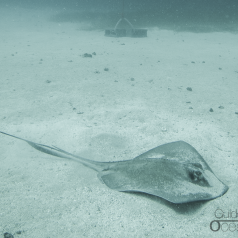
In the previous blog post, we grouped sharks and rays together to discuss their position in the marine food web. But how closely related are sharks and rays? And if we speak about sharks, are we right to include the ‘flat sharks’ a.k.a. rays as well? As you will see, sharks and rays are actually more similar that you would expect.
Fishes of which the skeleton is made up entirely of cartilage are called cartilaginous fish or ‘Chondrichthyes’ (in Greek khondros means cartilage and ikhthus means fish1). The class of cartilaginous fish is subdivided into the chimaeras (Holocephali, or ghost sharks) and the elasmobranchs (Elasmobranchii). All elasmobranchs possess 5-7 gill slits and their skin is made up of small ‘teeth-like’ scales (placoid scales). The elasmobranch subclass is further divided into sharks and rays2.
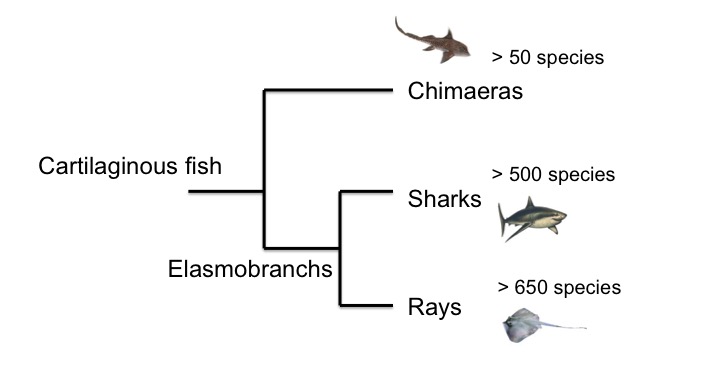
Obviously, the major difference between sharks and rays is their body shape. And in addition to the flattened body, the pectoral fins of rays are larger compared to those of sharks, and they are fused to the head, resulting in the unique body shape and swimming movements of rays. Furthermore, the gill openings of rays are located on the underside of the body, whereas the gills of sharks are located on both sides of the body.
Rays are generally more specialized in their food sources compared to sharks, making their distribution limited to smaller areas, and the distribution of many, more mobile, shark species greater2,3.
There are, however, a couple of species who’s appearance might trick you in assessing whether is a shark or a ray. For example, the similar-looking sawfishes and sawsharks are ray and shark species respectively, but both get their name from their saw-like rostrum. The major difference to distinguish the two is that sawfishes (rays) have the gill openings on the underside of the body, whereas the sawsharks have the gill slits on both sides of the body like all other sharks. In addition, sawsharks have a pair of long barbels on the underside of the rostrum. Sawsharks and sawfish do both use the rostrum for the same purpose: to stun prey2,4.
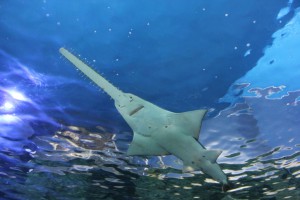
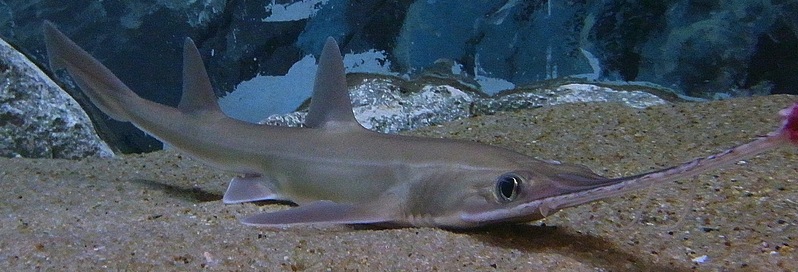
Another species that might lead to some confusion is the bowmouth guitarfish, also known as the shark ray (Rhina ancylostoma). It looks like a combination of a zebra shark (Stegostoma fasciatum) and a guitarfish (Rhinobatidae), but as the name suggests, this species’ gills are located on the underside of its body, making it a ray.
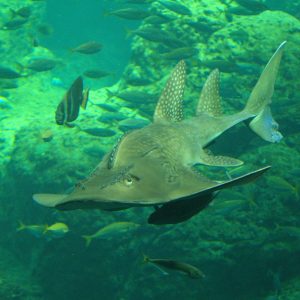
In fact, sharks and rays have a lot in common biologically and they are closely evolutionary related. About sharks we know from research that many species mature late, grow slow, and produce few offspring, rendering them vulnerable to exploitation. Similar studies on rays are still lagging behind2, but the available data indicate that rays might be just as vulnerable to exploitation as sharks are5. According to the IUCN Shark Specialist Group, the group of rays is even more threatened with extinction than sharks.
So it is pretty correct to think of rays as flattened sharks. Just like flounders are bony fish that are adapted to live on the bottom of the sea, rays are flattened elasmobranch fish adapted to live in seafloor habitats. However, our taxonomic system (the system of naming species) still distinguishes elasmobranch fishes into cylindrically shaped sharks and flattened rays.
-
- Klimley, A. P. (2013). The Biology of Sharks and Rays. University of Chicago Press.
- Last, P. R., White, W. T., de Carvalho, M. R., Séret, B., Stehmann, M. F. W., & Naylor, G. J. P. (Eds.). (2016). Rays of the World (First). New York: Cornell University Press.
- Navia, A. F., Mejía-Falla, P. A., López-García, J., Giraldo, A., & Cruz-Escalona, V. H. (2016). How many trophic roles can elasmobranchs play in a marine tropical network? Marine and Freshwater Research, 1–12.
- Ebert, D., Fowler, S., & Compagno, L. (2013). Sharks of the World: a fully illustrated guide. Wild Nature Press.
- Grubbs, R. D., Carlson, J. K., Romine, J. G., Curtis, T. H., McElroy, W. D., McCandless, C. T., Musick, J. A. (2016). Critical assessment and ramifications of a purported marine trophic cascade. Scientific Reports, 6(February), 20970.
Stingray picture and text by Guido Leurs





